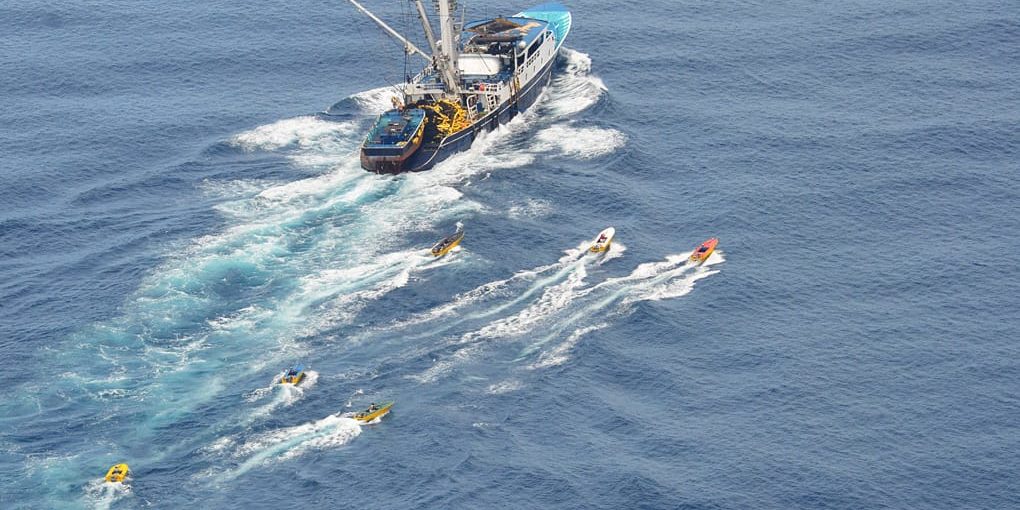The Fight Against Illegal Fishing in Costa Rica Goes High Tech and High Altitude
By providing satellite data on its fleets, Costa Rica is the latest country in Latin America to take on illegal fishing, which costs billions of dollars and taxes already over-exploited waters.
In July, the Costa Rican Institute for Fisheries and Aquaculture (INCOPESCA) signed an agreement to make its vessel tracking data publicly available through Global Fishing Watch (GFW), a partnership between international conservation group Oceana, satellite technology company SkyTruth, and Google. The process — completed in August — makes Costa Rica fourth the Latin American country to openly share vessel monitoring data with the organization, which tracks vessels on a publicly accessible map. Panama, Chile and Peru began sharing information with GFW in 2019. Indonesia was the first nation to do so.
The information, published with a 72-hour delay, aims to reduce illegal, unreported, and unregulated (IUU) fishing. Data is collected from the government’s Vessel Monitoring System (VMS) and through the Automatic Identification System (AIS), a mandatory navigational system for large boats that relays their locations to nearby vessels and coastal authorities.
The data is then used to create a near real-time map of fleets, with the aim of identifying commercial fishing vessels entering protected areas and ships that are carrying out illegal fishing operations.
The effort is not Costa Rica’s first attempt at protecting its waters. In 2015, the country’s National System of Conservation Areas (SINAC) and the Turtle Island Restoration Network launched a drone surveillance system to curb poaching and illegal fishing.
Costa Rica’s fisheries agency estimated that between 80 and 100 vessels use large illegal nets in the Pacific’s Gulf of Nicoya, capturing young fish. And the Cocos Island National Park, 550 kilometers from the mainland, has also been a constant target for illegal fishing.
According to the United Nation’s Food and Agriculture Organization, IUU fishing worldwide represents losses of between $10 to 23 billion each year. Aside from harming the environment and endangering marine species, such fishing also threatens the livelihoods of coastal communities.
InSight Crime Analysis
The latest move by the Costa Rican government to stop illegal fishing will hopefully add momentum to efforts to have other Latin American governments do the same.
An increase in the transparency of ships’ activity at sea can lead to a decline in IUU fishing, according to Mónica Espinoza, Global Fishing Watch’s regional manager for Latin America.
“Since the new monitoring system collects information on the vessel’s movement and activities, and can even distinguish if the monitoring systems have been turned off, it becomes much easier for GFW and authorities to detect illegal fishing activities,” Espinoza told InSight Crime.
SEE ALSO: Illegal Fishing Threatens Food Security in Bolívar, Colombia
At a global level, transparency in fishing operations is crucial. The Environmental Justice Foundation told InSight Crime in an email that “illegal operators are at low risk of capture and sanction by control authorities” because of the “challenges uncovering a vessel’s illegal activities, both current and past.”
While not part of the agreement, several other countries in the region are making headway as well. Countries like Uruguay, Argentina, and Chile publish data about fishing licenses and authorizations.
Earlier this year, Ecuador’s government approved a law increasing surveillance over its waters. Additionally, the Global Initiative against Organized Crime’s IUU Fishing Index lists Belize among the top ten countries with the best practices in combating illegal fishing.
But others have foundered. In Colombia, authorities have continuously failed to stop vessels from entering the Malpelo reserve on its Pacific coast. In Mexico, the fishing of totoaba — a type of drum that is banned from international trade but commonly poached off the Gulf of California — has driven the vaquita porpoise to the brink of extinction.
Efforts by Latin American countries to combat illegal fishing are also made difficult by foreign fleets — exemplified by the continued presence of 340 Chinese ships near Ecuador’s Galapagos Islands.
You May Also Like:
Stop Illegal Fishing in Costa Rica
Subscribe to Our Mailing List
[yikes-mailchimp form=”1″]



















